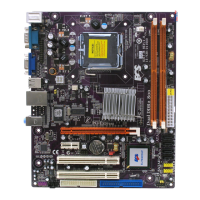
Do you have a question about the ECS G31T-M and is the answer not in the manual?
| Number of memory slots | 2 |
|---|---|
| Maximum internal memory | 4 GB |
| Processor socket | LGA 775 (Socket T) |
| Processor manufacturer | Intel |
| USB 2.0 ports quantity | 4 |
| Ethernet LAN (RJ-45) ports | 1 |
| Firewire (IEEE 1394) ports | 0 |
| Audio chip | Realtek ALC662 |
| Power source type | ATX |
| Audio output channels | 5.1 channels |
| Motherboard form factor | micro ATX |
| S/PDIF out connector | Yes |
| Graphics card | GMA 3100 |
| Maximum graphics card memory | 384 MB |
| LAN controller | Realtek RTL8101E |
| Networking features | Fast Ethernet |
| ACPI version | 1.0 |
| BIOS memory size | 64 Mbit |
| Depth | 200 mm |
|---|---|
| Width | 244 mm |
Overview of the G31T-M motherboard and its key features.
Details on CPU support, G31/ICH7 chipsets, and DDR2 memory specifications.
Information on optional onboard LAN and audio capabilities.
Details on PCI Express and PCI slots for add-on cards.
Description of rear panel I/O ports like PS/2, USB, VGA, LAN.
Overview of the BIOS utility and its configuration functions.
Visual identification and detailed listing of motherboard components.
Essential safety guidelines to follow during motherboard installation.
Guidance on choosing a compatible computer case for the motherboard.
Step-by-step instructions for mounting the motherboard inside the computer case.
Explains how to set and check motherboard jumpers for system configuration.
Detailed procedure for installing the CPU onto the motherboard socket.
Instructions for installing DDR2 SDRAM modules and a qualified vendor list.
Guide on installing expansion cards into PCI and PCI Express slots.
Information on connecting front panel headers, SATA, USB, LAN, and audio connectors.
Steps for installing Hard Disk Drives, CD-ROM, and Floppy Diskette Drives.
Details on connecting external devices to the motherboard's I/O ports.
Guide for connecting power supply connectors, fans, and front panel headers.
Introduction to the BIOS Setup Utility and its configuration capabilities.
Explains standard configuration and when to use the Setup Utility.
Procedure for accessing the BIOS Setup Utility upon system startup.
How to clear CMOS data and load default settings to resolve issues.
Explanation of the keys used for navigating and operating the BIOS menu.
Details on configuring date, time, and IDE/SATA device settings.
Configuration settings for advanced system features and performance.
Settings related to DRAM frequency, VGA memory, and other chipset features.
Enabling/disabling onboard IDE, SATA, LAN, Audio, COM, and Parallel ports.
Configuring ACPI suspend types, wake-up events, and power-off behavior.
Configuring settings for PCI bus devices and Plug and Play functionality.
Monitoring system temperatures, fan speeds, voltages, and fan control.
Adjusting CPU frequency, clock settings, and spread spectrum options.
Setting up supervisor and user passwords for system security.
Procedures for saving changes and exiting the BIOS setup utility.
Step-by-step guide for downloading and installing BIOS updates.
Overview of the software included on the support disc.
Guide for auto-installing drivers and utilities on Windows XP/Vista/7.
Instructions for manually installing drivers and software if auto-install fails.
Information on the available utility software and licensing.
Troubleshooting steps for power-up issues and no display during initial assembly.
Solutions for issues that arise after the PC has been in use for some time.
Basic PC care recommendations to prolong motherboard lifespan and performance.
A visual guide to diagnose and resolve common PC startup issues.
